Updated: January 2019.
Buying a pull-up bar can be harder than it sounds.
Not only are there many different products and brands on the market to evaluate, but there are also a variety of different types of pull-up bar to choose from, making the whole thing a bit of a minefield!
In this guide, I’m going to explain the different types of pull-up bars available and outline the advantages and disadvantages of each type in order to help you choose the best pull up bar for your needs.
You can also find links to Calisthenics 101’s top-rated bars within each bar type listed in this guide.
Table of Contents
What are the different types of pull-up bars available to me?
When it comes to buying a pull-up bar, there are 5 different types of pull-up bar to choose from.
Most people (understandably) only buy a single pull-up bar, so it is important to understand the advantages and disadvantages of each type of bar before you buy one.
Here are the 5 different pull up bar types:
- Free standing pull-up bars
- Pull-up stations, AKA “Power Towers”
- Wall mounted pull-up bars
- Ceiling mounted pull-up bars
- Doorframe mounted pull-up bars
- Still not sure which pull-up bar type is best for you?
Already know which type of pull-up bar is right for you?
Click the links below to jump to our top picks of each type, otherwise, continue reading to find out more about each bar type.
- Calisthenics 101’s list of best free standing pull-up bars
- Pull-up station (“AKA Power Tower”) top pick – Bodymax CF362 Power Tower
- Calisthenics 101’s list of best wall mounted pull-up bars
- Ceiling mounted pull-up bar top pick – Gymcor Commercial Ceiling Mounted Pull-Up Bar
- Calisthenics 101’s list of best doorframe pull-up bars (scroll down the page!)
Let’s look at each different type of pull-up bar and consider its advantages and disadvantages, and why it may be the best pick for you.
Free Standing Pull-Up Bars
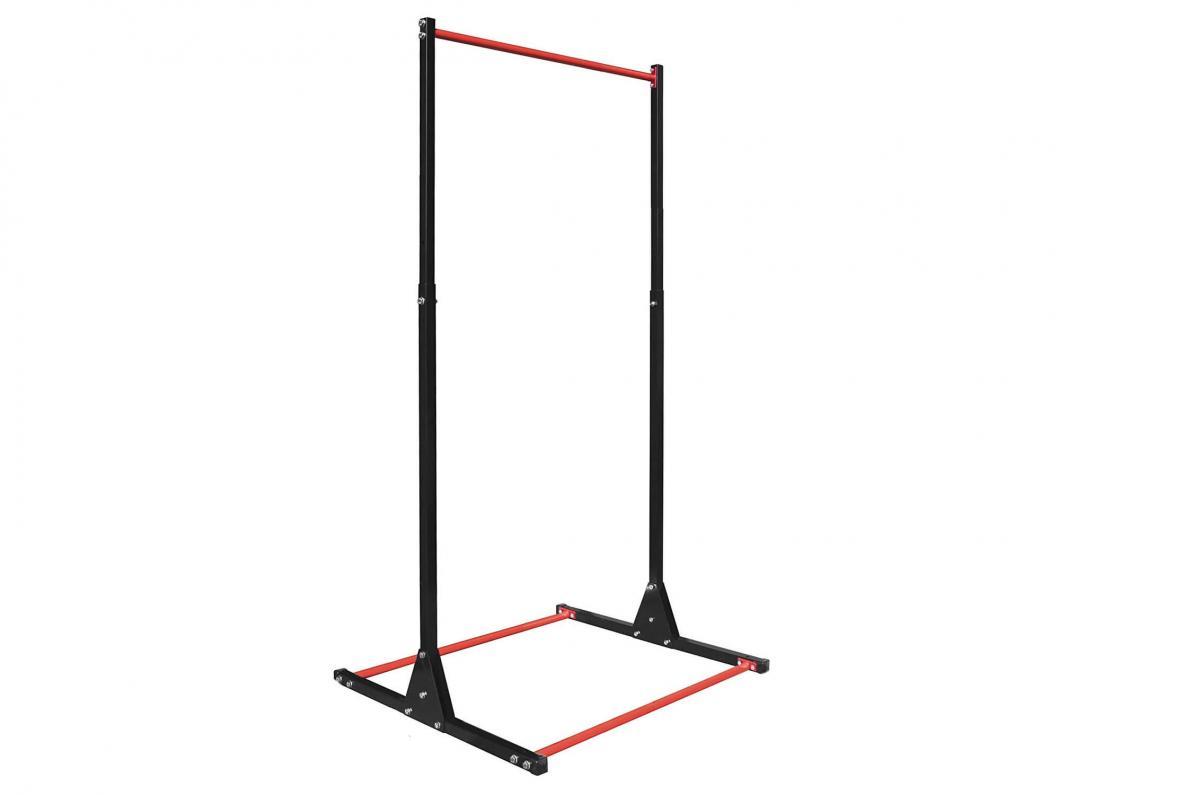
The free standing pull-up bar type is best suited for those who don’t want to be limited by space around and on top of the bar – no more banging your head on the ceiling or hitting your legs on the wall!
Having the luxury of free space around the pull up bar means that you can also attempt a wider range of exercises that require more space than a simple chin up. With this type of bar you can complete more advanced bodyweight exercises such as muscle-ups, front and back levers, human flags and straight bar dips; exercises which are not possible on some of the other bar types which limit the users available space.
In the free standing pull-up bar range you will often come across two different options; a purpose designed bar which can easily be dismantled and transported, or a squat rack type structure which can be used as both a pull-up bar and a weights rack which can hold a barbell if desired.
Within the world of calisthenics, the purpose designed bars such as Gravity Fitness’s free standing pull up bar or the Pull Up Mate are the most popular choices here.
Read our guide to the best free standing pull-up bars
Pull-Up Stations AKA ‘Power Towers’
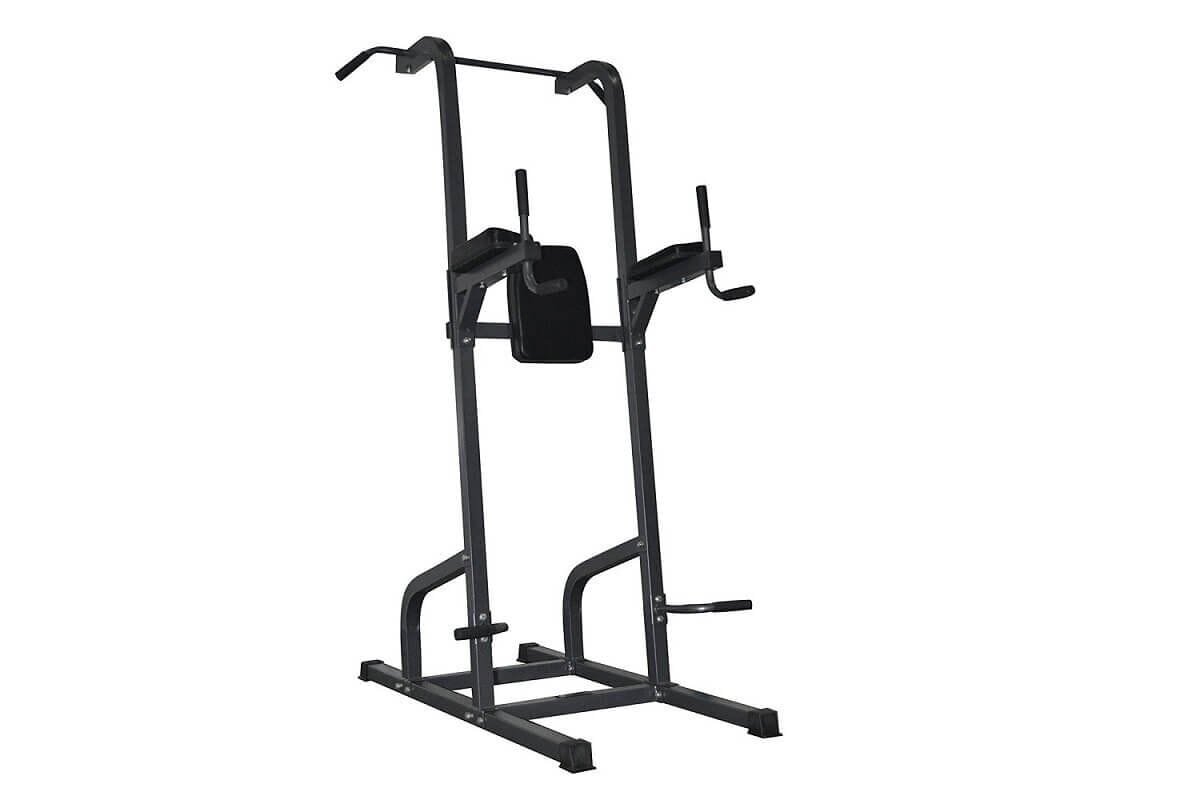
Of the different types of pull-up bars listed, a pull-up station is the one you’re most likely to have seen or used in a regular gym.
Often referred to as a ‘Power tower’, a pull-up station is a larger ‘all-in-one’ piece of equipment that you can use to perform pull-ups, dips, hanging leg raises, and various other exercises on. This makes it great for those looking for a single piece of equipment that they can use for a full body workout.
A pull-up station is often the most expensive of the different types and is also the largest. The size and shape of most pull-up stations are similar to that of a free standing pull-up bar (if not bigger), however, it is designed to be assembled once and not dismantled, so it is the most space consuming of all the different types.
Read our guide to the best power towers for home use
Wall Mounted Pull-Up Bars

Wall mounted pull-up bars are the first bar type in this guide which I would consider a permanent fixing – the bar is bolted into the wall meaning it cannot (easily) be moved once assembled.
This kind of pull-up bar is great for those looking for a solid and sturdy structure. Some users may not feel confident with a doorframe pull-up bar, and other users may also prefer something more rigid than a free standing pull-up bar, which is where a wall mounted pull-up bar would benefit.
Wall mounted pull-up bars are also the most common pick for those looking to fix a pull-up bar to the outside of a house or garage. Most of these types of pull-up bar are durable and known to hold up pretty well in all kinds of weather (though as an Englishman I could never trust anything to last a year in our awful climate!).
The main disadvantage of this bar type is what some users would consider a lack of space between the bar and the wall. This does force you to maintain a stricter pull-up technique but can feel restricting for those who wish to use the bar for other calisthenics techniques which require more space.
Read our guide to the best wall mounted pull-up bars
Ceiling Mounted Pull-Up Bars
A ceiling mounted pull-up bar is very similar in style and price to the wall mounted pull-up bar, but it is of course designed to be mounted from the ceiling instead of a wall.
This may mean the arms/handles will be angled differently, and there will most likely be extra space between the bar and the fixings. This allows the user to perform exercises above the bar without hitting their head on the ceiling.
A ceiling mounted pull-up bar is ideal for those who have exposed beams in their house or garage and want to get the most out of the available space.
Doorframe / Doorway Mounted Pull-Up Bars
A doorframe pull-up bar is typically the cheapest of the different varieties and by far the easiest to install.
This type of pull-up bar can be simply mounted within the doorframe and is designed so it can be easily removed from the frame when not in use.
There are usually two methods used to do this:
- Two small circular brackets are permanently mounted on the inside edge of the doorframe, and the bar can be slotted into these brackets when in use.
- A more complex bar design allows the user to position the bar around the doorframe so that it is held in place without the need to drill or screw anything into the doorframe.
The doorframe pull-up bar type is best suited for the beginner user whose main focus is to increase their chin-up and pull-up reps within their own home, those on a shoestring budget, or for those who are limited by space or the flexibility to drill and fix a bar to their wall. This type of bar is, as you’d imagine, the most popular choice for students, teenagers, or anybody else living in rented accommodation.
Below you can find a short list of my top 3 picks for what I think are the best door frame pull-up bars on the market.
Top tip: I’ve also included a section at the end of this post on how to install a door frame pull-up bar since I’ve found the simple door frame bars don’t include any instructions. I’ve gone through the pain of figuring that out so you don’t have to!
The 3 Best Door Frame Pull-Up Bars
#1 Trend-Welt Door-Mount Pull-Up Bar
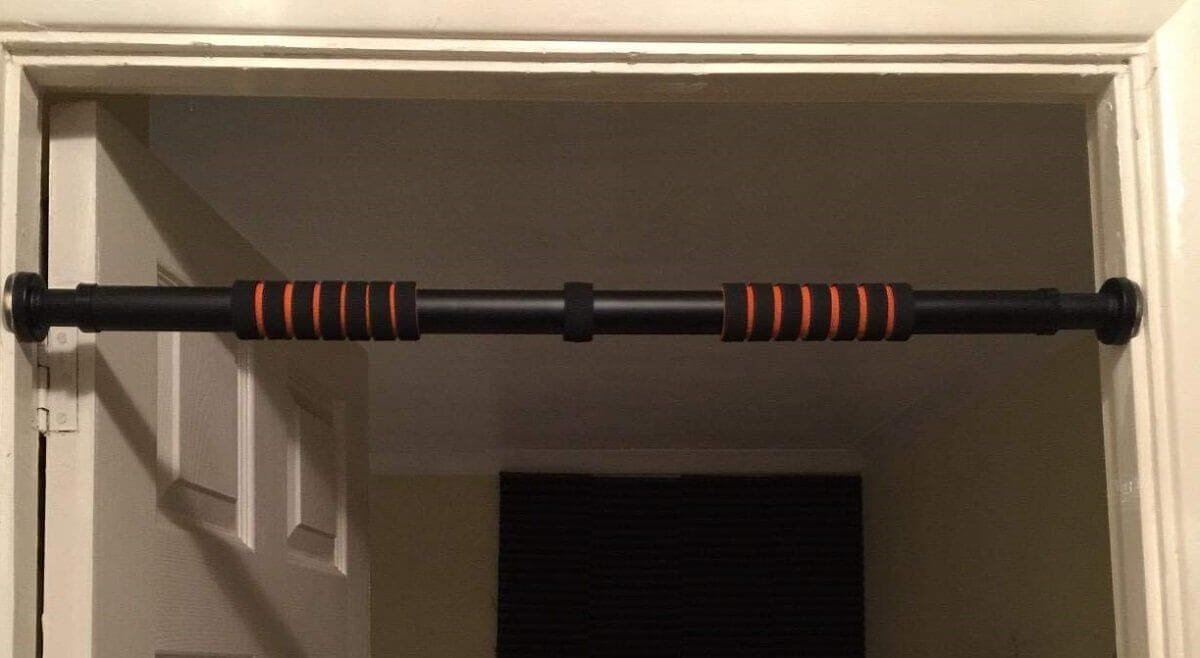
The Trend-Welt pull-up bar is the highest rated bar of the telescopic bar types which fit between the door frame without the need for fixings.
The bar ranks at number one on my list as it is the cheapest of the three reviewed here, yet still does a top job without issues, making it the best value pull-up bar.
What I love about bars of this type is that they can be easily re-positioned for different exercises. For example, you could set the bar up with or without the fixings at a higher level for pull-ups and chin-ups, but you could easily re-position the bar a bit lower to work on Australian Pull-Ups, and then lower again to work on straight bar dips. This could all be done within the same workout, taking no longer than you would need rest between sets to re-position the bar.
The bar can support a maximum weight of 150kg without the fixings, but that increases as high as 300kgs if the fixings are used. Be sure to check your door frame is of a high enough quality, as I have found that these figures are meaningless if you have an old and/or terribly fitted door frame which creaks and moves when force is applied to it.
The bar also comes with transparent rubber ends to avoid leaving any marks or traces on your door frame – a great feature for those of you who are renting your house and are keen to not do anything that would jeopardise your deposit!
Check the price of the Trend-Welt Door-Mount Pull-Up Bar on Amazon
#2 Powerbar 2
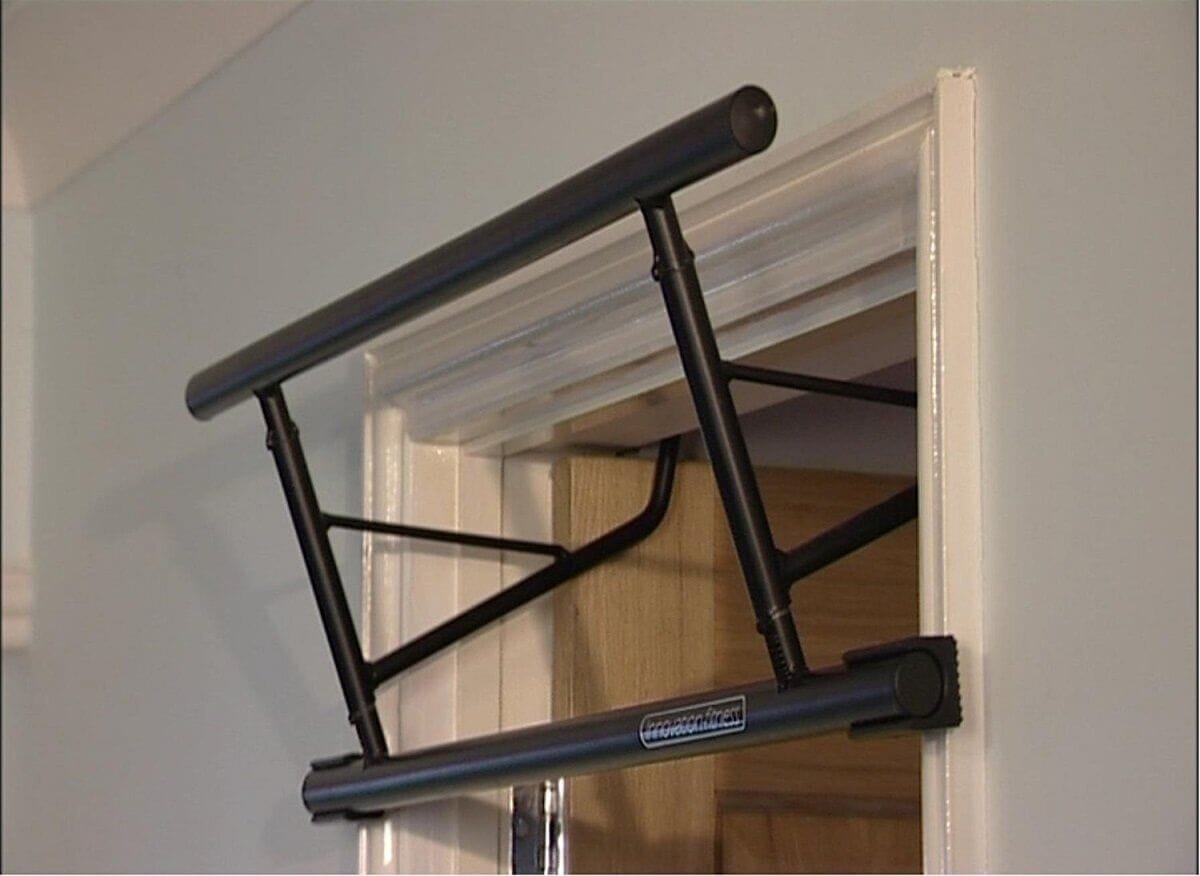
The Powerbar 2 is one of the most loved door frame pull-up bars due to its simplicity.
The Powerbar 2 is an ‘over the frame’ type bar which has been designed to be as minimalist as possible, instead concentrating on being the most solid bar of this type on the market.
Where other bars of this type have to be screwed together in order to give the user a variety of different grip combinations (see the Sporastisch “Get Strong” bar), the Powerbar 2 is delivered as one single welded item.
For those wanting strength over versatility, the Powerbar 2 is #1 contender.
Another feature that is unique about the Powerbar 2 is the way the supporting bar sits against the door frame beneath the actual pull-up bar. This means that when using the bar, more of your weight is transferred against the door frame rather than pulling down on the frame, giving you a more solid feeling, and hopefully extending the life of your door frame!
The design also means the pull-up bar is positioned at a similar height to the top of the door frame, which means this pull-up bar type is better suited to taller users who find the bars that extend between the door frame not as suitable for them.
The only problem with the Powerbar 2 is how thin the bar is, since some users may desire a thicker bar to grip on to. Many users have reportedly wrapped tennis grip tape around the bar to make it thicker, however, if you are strong enough you may find that a pair of Fatgripz also does the trick.
Check the price of the Powerbar 2 on Amazon
#3 Sportastisch ‘Powerful’ Pull-Up Bar
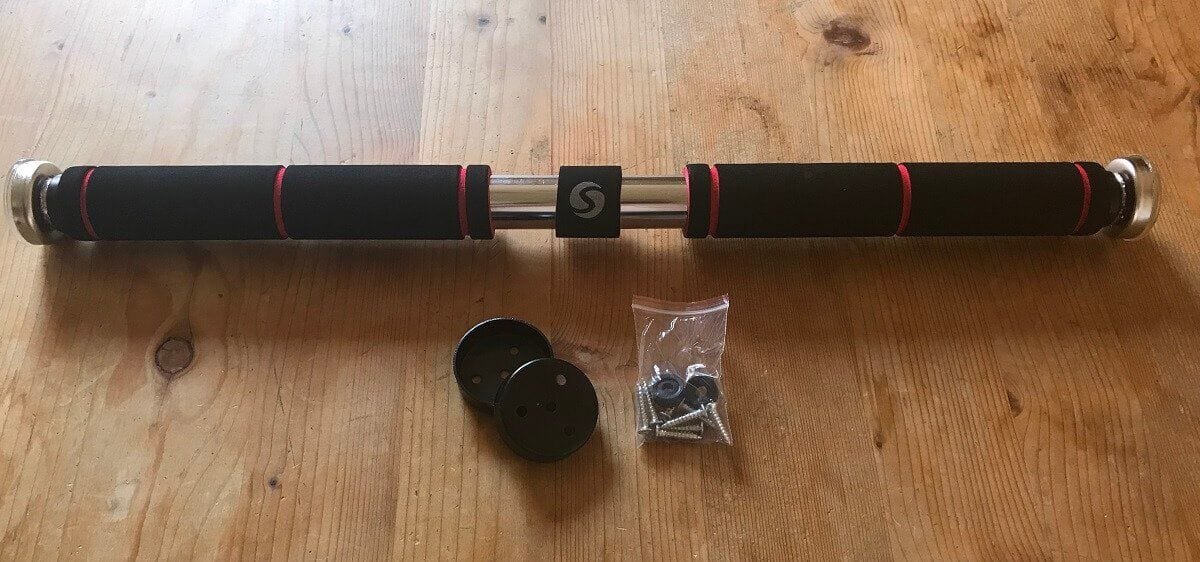
The Sportastisch ‘Powerful’ Pull-Up Bar was one of two Sportastisch bars I reviewed in this dedicated post.
The bar is very similar to the Trend-Welt bar in that it is a telescopic-type bar which can be positioned between the doorframe without needing to use the optional fixings.
I believe which bar you choose is down to personal choice, however, I have ranked Sportastisch’s bar below Trend-Welt ‘s bar for the following reasons:
- It is marginally more expensive
- It supports less weight in total
- Much more of the bar length is covered in padding material, whereas I prefer to have less of the bar covered so I have the option to grip the non-padded areas of the bar
Check the price of the Sportastisch 'Powerful' Pull-Up Bar on Amazon
Installation Tips For The Telescopic Pull-Up Bar Types
The common type of doorframe bar is the ‘telescopic bar’ which aims to fit between your doorframe without the need for screws or any DIY (in most cases that is).
Installing a bar of this type should be simple in theory, but for many, it is far from it! For those who are puzzled, here’s a quick guide on how to set the bar up correctly:
- Find a solid door frame with flat faces that are wide enough to accommodate the rubber ends of the bar.
- Unscrew the bar at each side (usually anti-clockwise) until both sides are extended long enough to fit into the frame snuggly, but not tight. Move the bar to the desired position so it sits horizontally at the desired height.
- To tighten the bar to the door frame you now need to rotate the central section of the bar (be sure to adapt your grip to the direction of tightening). Because the central section is connected to the telescopic arms via a screw thread, tightening this will rotate both of the telescopic arms in a direction which extends the width of the whole bar and tightens the bar within the frame.
- Make sure you perform exercises on the correct side of the bar so that your grip doesn’t inadvertently loosen the bar. For example, if you are doing chin-ups using an underhand grip, you will pull the other side of the bar downwards, rotating the bar anti-clockwise. If you are doing pull-ups using an overhand grip, you will pull the facing side of the bar downwards, rotating the bar clockwise.
Always proceed with caution when first attempting exercises on a door frame pull-up bar, until you are confident that the bar is securely tightened within the frame, and that the frame is strong enough to hold the bar and your weight.
Still not sure which pull-up bar type is best for you?
Although the above recommendations should have given you a better idea of which pull-up bar type suits you, there are a few other factors you need to account for when purchasing a pull-up bar which may help you make that choice.
Weight Limit
Each bar has a maximum user weight listed on it, which is most commonly between 100KG and 200KG.
Most users won’t be affected by the supported weight, however, you should also factor how much weight the supporting structure can hold. For example, if you have purchased a pull-up bar which attaches to your doorframe, are you sure that the doorframe itself will hold your weight?
Height Limitations
You also need to consider your height.
If you are over 6ft, you will likely find a doorway pull-up bar is hard to use, and you may also find that you struggle to position a wall mounted pull-up at a desirable height unless you have high ceilings or can mount it outdoors.
Setup Requirements
Each pull-up bar type has a completely different set of requirements.
A wall mounted or ceiling mounted pull-up bar will require at least two people to set up, and will involve some DIY as you will likely need to drill into your wall or ceiling.
A free standing pull-up bar, on the other hand, can be assembled easily by a single person and can be done without any additional tools.
Make sure you have the resources and tools to correctly mount or assemble whichever bar you choose, as the supporting weight and warranty will only apply if the bar is assembled correctly.
Summary: Recommended Pull-Up Bars
You should hopefully have decided which pull-up bar suits you best by now. Use the following links to jump to our ‘Best of’ lists for each bar type:
- Calisthenics 101’s list of best free standing pull-up bars
- Pull-up station (“AKA Power Tower”) top pick – Bodymax CF362 Power Tower
- Calisthenics 101’s list of best wall mounted pull-up bars
- Ceiling mounted pull-up bar top pick – Gymcor Commercial Ceiling Mounted Pull-Up Bar

Founder of www.calisthenics-101.co.uk. Training calisthenics since 2012.
Currently working on: 30 second one-arm handstand, muscle-up 360, straddle planche.